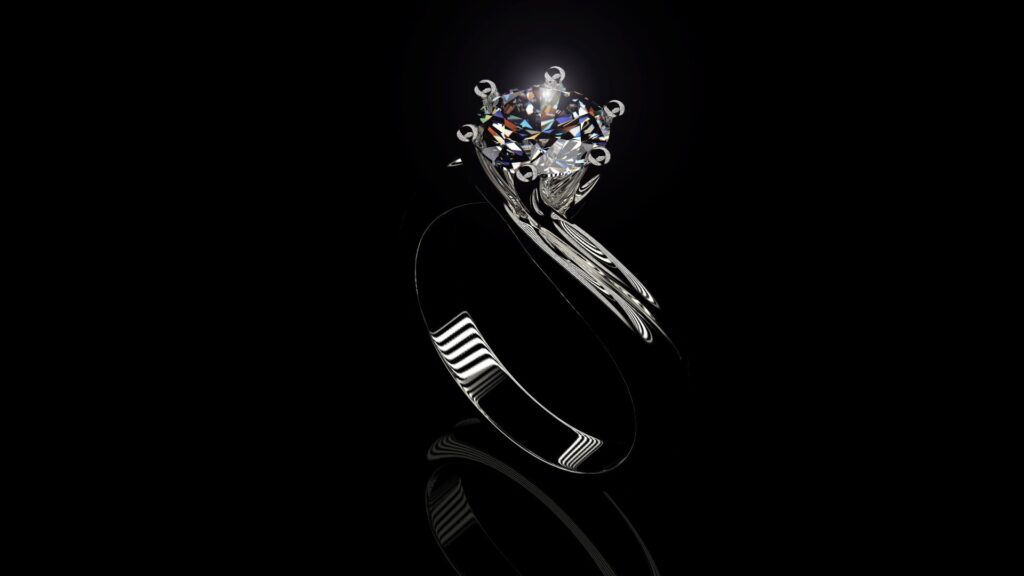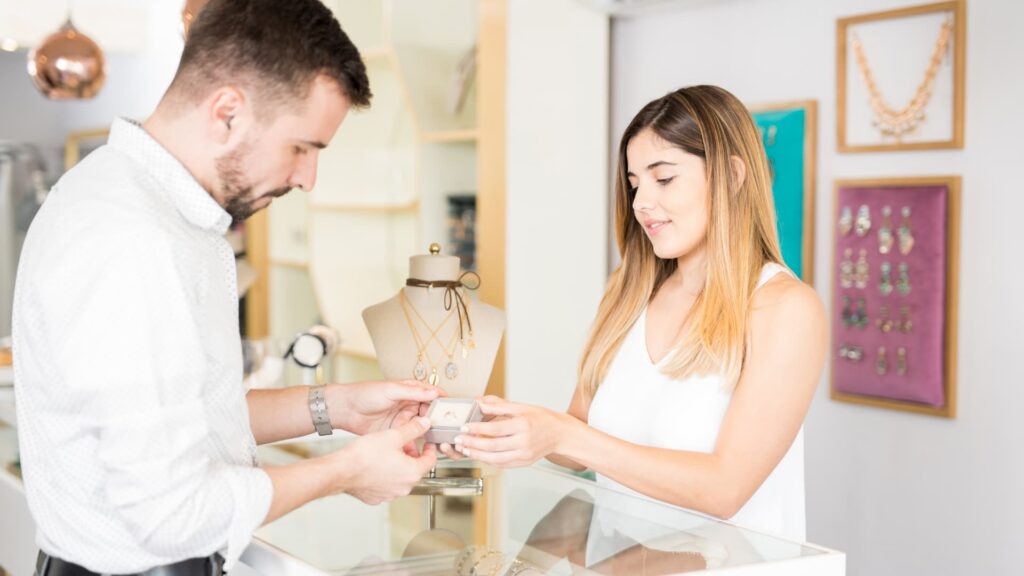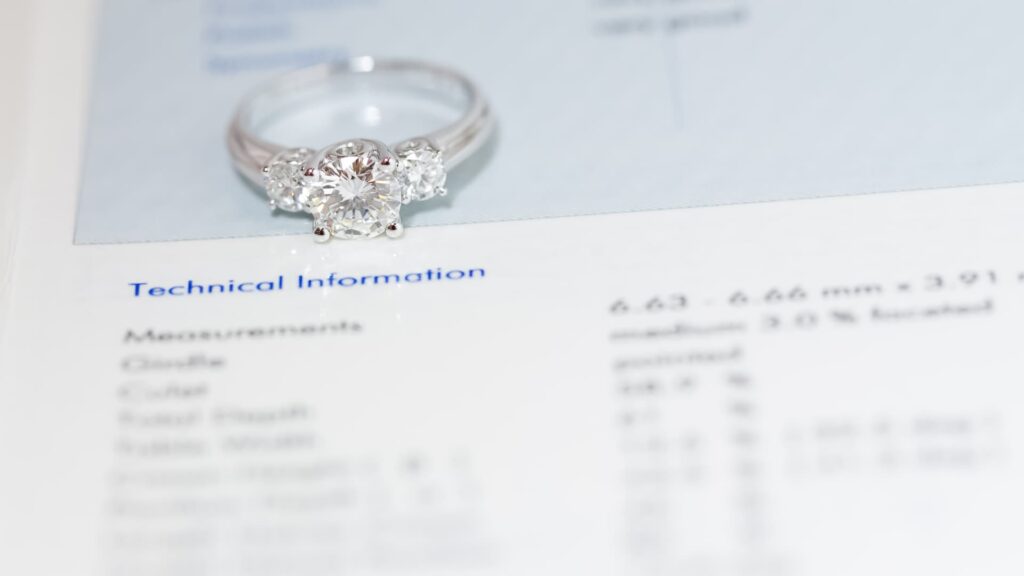Sometimes, when you look at your diamond ring in sunlight, you might notice that the diamond gives a hint of blue color. You might become a bit concerned because diamonds aren’t supposed to be colored, right? Did you buy a fake?
Don’t worry; you weren’t duped by anyone. This bluish tint is called diamond fluorescence. It is a visible glow that your diamond emits when exposed to high-wave ultraviolet rays of the sun.
But all diamonds do not show this phenomenon. Only 25-30 percent of diamonds will fluoresce when they come in contact with UV light, and most of them will look blue.
The blue fluorescence happens because of nitrogen atoms that got caught in the carbon lattice when it was being formed deep under the surface of the earth. In rare cases, you may also see a yellow, red, or orange glow from your diamond.

Why Does My Diamond Look Blue In Sunlight?
There can be two reasons why your diamond looks blue in sunlight. The first is because of fluorescence, and the second is due to a diamond’s sky reflection.
It is estimated that only 25-30 percent of real diamonds have fluorescence to some extent. Out of this, 90 percent will glow blue under strong UV rays. Diamonds produce strong fluorescence and will only glow blue in UV light.
But if you have a colored blue diamond, it will glow blue in every light.
Now let’s discuss the second reason. When the sun is bright, and the sky is clear blue, the color of the sky gets reflected from the surface of a well-cut stone. This might make it appear blue. But once you move to a shaded place, your diamond ring will not glow blue anymore.
See how the blue fluorescence of a diamond looks in this video of a James Allen engagement ring:
What Is Fluorescence?
Diamonds can have traces of elements like boron, nitrogen, or aluminum during formation. The electrons of these trace elements absorb energy from ultraviolet light and emit energy by means of photons to return to their natural state.
The glow we see due to these photons emitting is fluorescence. If more trace elements are present on the diamond crystal lattice, your diamond ring will glow bluer when kept under UV light.
While diamonds are usually graded on the 4C’s (cut quality, carat weight, clarity, and color), fluorescence is one more parameter that diamond sellers and buyers often use to grade one. The International Gem Society (IGS), for example, grades diamonds under UV light, hence a more fluorescent diamond will likely give a lesser price if it is graded by them.
Is There A Grade For Diamond Fluorescence?
The Gemological Institute of America has also described diamond fluorescence based on ultraviolet light, which can be one of five options: none, faint, medium, strong or very strong. Higher the fluorescence, the higher the glow when exposed to sunlight or UV rays.
- None: A diamond with no fluorescence is put in this class.
- Faint: The diamond classified in this class exhibit a small amount of fluorescence, which is not noticeable to the naked eye.
- Medium Fluorescence: The diamonds with medium fluorescence will emit strong blue light when exposed to long-wave ultraviolet rays of the sun. But your diamond may appear slightly milky or cloudy to the naked eye.
- Strong Fluorescence: The diamonds with strong fluorescence will emit strong blue color under UV light. The diamond may appear very milky or hazy to the naked eye.
- Very strong fluorescence: The diamonds with very strong fluorescence will emit intense blue light under UV rays, and the diamond will look extremely cloudy when seen under the naked eye.
Does A Yellow Diamond Look White Because Of Fluorescence?
Some diamond professionals believe that blue fluorescence can increase the gemstone’s appearance. GIA color grading scale starts from D(colorless), grows in color, and ends in Z. The diamonds having color grades from I to M usually have yellow tints.
If you purchase such a color grade with medium to strong fluorescence, it will look whiter in sunlight. That’s why these diamonds are sold at a higher price per carat than diamonds with the same grade but with lower fluorescence.
See also: James Allen Yellow Diamonds
The diamonds which have color grades from D to H appear colorless. Professionals believe that diamonds with high color grades (D to H) with medium to strong fluorescence will have a hazy effect. That’s why their price is slightly lower than diamonds with the same color grade but without fluorescence.
However, a study by the Gemological Institute Of America recently says that blue fluorescence does not affect the appearance of diamonds except in a few cases. For instance, if the diamond has a light scattering issue, then the fluorescence will affect the look of the diamond.
But these defects are sporadic. So, most diamond consumers should not get worried about fluorescence’s impact on the look of diamonds.
Related article: What Are Fancy Yellow Canary Diamonds?
Can A Buyer Tell The Difference Between Fluorescent And Regular Diamonds?
The scientists of the Gemological Institute Of America assembled the E, G, I, and K color-grade diamonds to study the fluorescence effect on appearance. The diamonds of every set were alike except for the degree of fluorescence. The diamonds were allowed to be observed under controlled conditions by diamond buyers.
Most of them could not figure out any difference the blue fluorescence has on the appearance of the diamond. Some viewers commented that the diamonds with strong fluorescence had a good appearance when viewed from the top.
Is Fluorescence In Diamond Good Or Bad?
Diamond fluorescence is neither good nor bad. Some buyers like blue fluorescent diamonds, while others don’t like wearing such diamonds.
So, there is no direct answer to this question. If you are purchasing a blue fluorescent diamond ring, visualize it in various lights, including UV light, and compare it with diamonds of similar color grade.
How Can I See Whether My Diamond Is Fluorescent Or Not?
You can check the diamond certificate which you must have got while purchasing. Diamonds with a GIA certificate usually enlist fluorescence properties and how your diamond is affected by UV light intensity.
The other way is to watch the diamond under a strong UV-ray light bulb.
Frequently Asked Questions
How should a diamond look in sunlight?
A natural diamond will sparkle grey and white when you look in the sunlight. The outside of your diamond ring should reflect rainbow colors on its numerous surfaces. The intense ultraviolet rays of the sun usually do not affect most diamonds.
But if you purchase diamonds with strong fluorescence, they will emit blue light under strong sunlight. Note that normal light will not affect the fire, brilliance, and sparkle. The color of the diamond will only change when exposed to UV rays.
Do natural diamonds turn blue under UV light?
Yes, and the diamonds that exhibit this property are known as fluorescent ones. This phenomenon will enable a diamond to emit blue light under UV light, but all natural diamonds will not have fluorescent properties.
The diamonds with medium to strong fluorescence are the only ones that will glow in blue color in UV light. Fake diamonds will glow some other color or will not emit any light when kept under UV light.
What causes a diamond to be blue?
During formation, impurities like boron, nitrogen, or aluminum can get inside the diamond crystal lattice. These impurities absorb UV light and release energy through photons, and thus your diamond glows when exposed to sunlight.
If high quantities of boron are present in the diamond crystal, it will emit blue light when exposed to UV rays.
What does a diamond glowing under UV light signify?
When a diamond glows under UV light, it indicates that it has few minerals inside it as impurities. That will not affect the diamond’s sparkle, brilliance, or fire. Mineral traces will change your diamond color ring when exposed to the sun’s ultraviolet rays.
Wrap Up
The ultraviolet rays of the sun do not affect most diamonds. But diamonds with medium to strong fluorescence may produce blue light under high wavelength ultraviolet light. But these diamonds will stop emitting blue light when you move indoors or in the shade.
Fluorescence is an important property and can change the color of the diamond. You cannot say it is good or bad. Many jewelers advise purchasing diamonds with strong fluorescence as the diamond will sparkle in almost all situations, but a few others say the exact opposite. Thank you for reading this article.
Related article: Tanzanite Vs. Diamonds: What’s the Difference?






